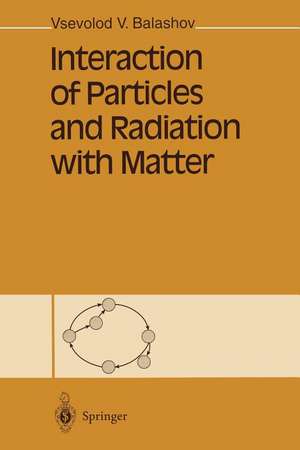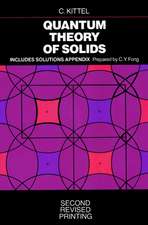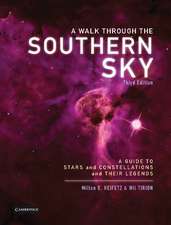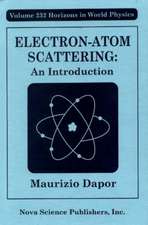Interaction of Particles and Radiation with Matter
Traducere de G. Pontecorvo Autor Vsevolod V. Balashoven Limba Engleză Paperback – 17 sep 2011
Preț: 385.84 lei
Nou
Puncte Express: 579
Preț estimativ în valută:
73.85€ • 80.25$ • 62.08£
73.85€ • 80.25$ • 62.08£
Carte tipărită la comandă
Livrare economică 21 aprilie-05 mai
Preluare comenzi: 021 569.72.76
Specificații
ISBN-13: 9783642643835
ISBN-10: 3642643833
Pagini: 256
Ilustrații: XI, 238 p.
Dimensiuni: 155 x 235 x 13 mm
Greutate: 0.36 kg
Ediția:Softcover reprint of the original 1st ed. 1997
Editura: Springer Berlin, Heidelberg
Colecția Springer
Locul publicării:Berlin, Heidelberg, Germany
ISBN-10: 3642643833
Pagini: 256
Ilustrații: XI, 238 p.
Dimensiuni: 155 x 235 x 13 mm
Greutate: 0.36 kg
Ediția:Softcover reprint of the original 1st ed. 1997
Editura: Springer Berlin, Heidelberg
Colecția Springer
Locul publicării:Berlin, Heidelberg, Germany
Public țintă
ResearchDescriere
Beginning with a concise introduction on the constituents of matter (elementary particles, atomic nuclei, atoms and molecules), this course on the structure of matter focuses on the interaction of particles and radiation with matter. The course is divided into fourteen lectures with each ranging from physical fundamentals to current topics in subatomic and atomic research, thus making links to modern applications. Currently important topics such as channeling, the interaction between molecular ions and matter, and muon-catalyzed fusion are also discussed. The text is suitable as an introduction for graduate students and as a reference for scientists.
Cuprins
Introduction: Fundamentals of the Structure of Matter.- A. Elementary Particles.- B. The Atomic Nucleus.- C. Atoms and Molecules.- I. Interaction of Charged Particles with Matter.- First Lecture.- 1.1 Ionization Stopping and Multiple Scattering of Fast Heavy Particles in Disordered Media: Relationship Between Parameters Characterizing the Passage of Particles Through Matter and Characteristics of Elementary Processes.- 1.2 The Classical Theory of Ionization Stopping.- Second Lecture.- 2.1 Quantum Theory of Ionization Stopping of Fast Charged Particles.- 2.2 Stopping Times and Path Ranges of Particles in Media.- 2.3 Calculation of the Average Multiple-Scattering Angle.- 2.4 Straggling: Fluctuations of Ionization Losses.- Third Lecture.- 3.1 “Dielectric Theory” of Ionization Stopping.- 3.2 Application of the “Dielectric Theory”: Ionization Stopping in a Rarefied Gas.- 3.3 Stopping of a Charged Particle in a Degenerate Electron Gas.- 3.4 Local Density Approximation.- 3.5 Relativistic Effects: The Bethe-Bloch Formula.- Fourth Lecture.- 4.1 Ionization Stopping of Slow Particles.- 4.2 Bragg’s Composition Law.- 4.3 The Stopping Power of a Medium for Particles and Antiparticles: The Z3 Correction to the Bethe-Bloch Formula.- 4.4 Passage of Multiple-Charged Ions Through Matter.- 4.5 The Passage of Electrons Through Matter.- Fifth Lecture.- 5.1 Channelling.- 5.2 The Shadow Effect (Blocking).- Sixth Lecture.- 6.1 Interaction of Molecular Ions with Matter.- 6.2 Application of the Method of Computer Simulation.- II. Interaction of Electromagnetic Radiation with Matter.- Seventh Lecture.- 7.1 Passage of ? Radiation Through Matter.- 7.2 Interaction of ? Quanta with the Atomic Nuclei of Matter. The Mössbauer Effect.- Eighth Lecture.- 8.1 Rotation of the Plane of Polarization of Light as an Effect Due to Parity Violation in Atoms.- 8.2 Experimental Observation of Parity Violation in Atoms.- Ninth Lecture.- 9.1 Electromagnetic Radiation Caused by the Passage of Particles Through Matter: Direct Processes.- 9.2 Characteristic Radiation of the Atoms of a Medium Due to the Interaction of Particles with Matter.- 9.3 Angular Anisotropy of the Characteristic Radiation. The Alignment Phenomenon of Atoms in a Medium.- 9.4 Electromagnetic Radiation in Charged Particle Channelling.- III. Interaction of Neutrons with Matter.- Tenth Lecture.- 10.1 Elementary Theory of the Slowing Down of Neutrons.- 10.2 The Mean Stopping Time of a Neutron: The Stopping Path.- Eleventh Lecture.- 11.1 Motion of Neutrons Upon Thermalization: The Diffusion Coefficient.- 11.2 The Equation of Diffusion: The Mean Lifetime of the Neutron.- 11.3 Typical Problems of Thermal Neutron Diffusion Theory.- 11.3.1A Stationary Point Source in an Infinite Medium.- 11.3.2 Boundary Conditions for Neutrons Passing from a Medium to Vacuum.- 11.3.3 Diffusion of Thermal Neutrons from a Point-Like Pulsed Source.- Twelfth Lecture.- 12.1 Neutron Diffraction in a Crystal.- 12.2 Coherent and Incoherent Neutron Scattering.- 12.3 The Influence of Thermal Oscillations of the Lattice: The Phenomenon of Inelastic Diffraction.- 12.4 Neutron Scattering by Polycrystals.- IV. Mesoatomic and Mesomolecular Processes.- Thirteenth Lecture.- 13.1 Mesoatoms and Their Properties.- 13.2 Cascade of Electromagnetic Transitions in Mesoatoms: Influence of the Medium on a Mesoatomic Cascade.- 13.3 Methods Involving Pions and Muons in Chemical Studies.- 13.3.1 Analysis of the Composition and Structure of Matter Based on Mesonic X-Rays.- 13.3.2 Charge Exchange of ? Mesons on Hydrogen Nuclei.- 13.3.3 Polarization and Depolarization of Muons in Muonic Atoms.- 13.3.4 Muonium.- Fourteenth Lecture.- 14.1 The Formation of Mesomolecules.- 14.2 Muonic Catalysis of Nuclear Fusion.- References to Figures and Tables.
Textul de pe ultima copertă
This book is organized into fourteen lectures on modern atomic and nuclear physics. It begins with a concise introduction on the constituents of matter (elementary particles, atomic nuclei, atoms and molecules) and then focuses on the interaction of particles and radiation with matter. The lectures each range from physical fundamentals to current topics in subatomic and atomic research, thus making links to modern applications. Currently important topics such as channeling, the interaction between molecular ions and matter, and muon-catalyzed fusion are also discussed. The text is suitable as an introduction for graduate students and as a reference for scientists.
















